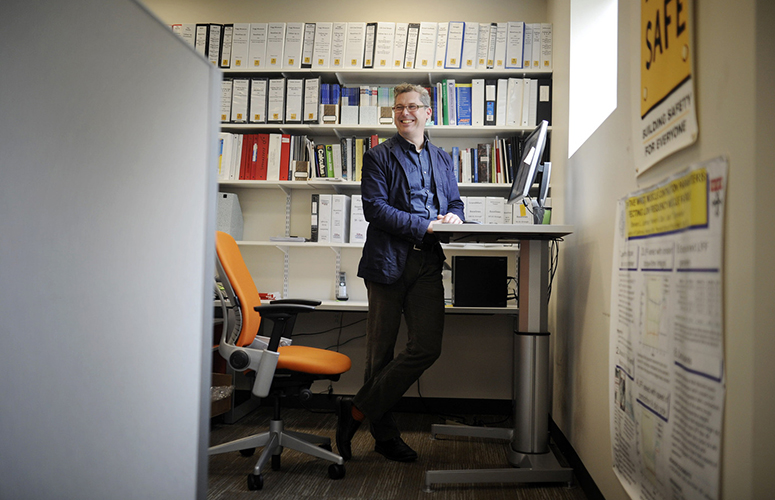Stand up, sit down, type, type, type

If sitting is the new smoking, does that make standing desks a breath of fresh air?
We don’t know because research on the benefits of standing desks is slim. But a new study led by Jack T. Dennerlein, professor in the Department of Physical Therapy, Movement, and Rehabilitation Sciences, suggests that isn’t even the right question.
To date, there are no ergonomic guidelines for setting up standing workstations. Before assessing benefits, researchers need to ask: What’s the best way to use these desks?
Dennerlein and his colleagues aimed to answer that. In the study, which appeared in the journal Human Factors, they found that users arranged their sitting and standing setups differently, and that when it came to standing, they varied markedly from one another in the way they positioned the mouse, monitor, keyboard, and desk height. Each person, says Dennerlein, adjusted the components “to find his or her own ‘sweet spot.’” The results pave the way for developing ergonomic guidelines for these popular workstations.
“Our research finds that one size does not fit all,” says Dennerlein. “People have a lot of different ways to find comfort in their standing workstations. We need to tell them: ‘Find what works for you.’” Researchers, too, have to be flexible, he says. “We need to question our assumptions about variables such as ‘proper’ posture as we go forward.”
Perceptions drive reactions
The study, a collaboration with researchers at the Harvard T.H. Chan School of Public Health, was small but rigorous. The team used a “psychophysical” approach, which zeroes in on how people’s perceptions drive their reactions to the environment.
Our research finds that one size does not fit all.
— Jack T. Dennerlein, professor
In a laboratory setting, 20 adults, none of whom had ever used a standing desk, alternated doing computer work at sit-stand workstations in four 45-minute sessions. Every 11.25 minutes, the researchers would enter and disrupt the workstation arrangements, after which the participants would readjust them to what they felt were the most comfortable positions. The researchers tracked the movements with infrared light-emitting diodes placed on each component as well as the user’s head, torso, and upper arm.
That the participants’ choices varied so much surprised Dennerlein. “Sit-stand desks are highly adjustable—there are a lot of variables to make the workstation fit you,” he says. “The solution for what works for people turned out to be larger than just one value for each of those variables.”
From the lab to the workplace
Dennerlein’s own experience with a standing desk sparked the research. “I realized I was setting up my sit-stand workstation differently when I was sitting than when I was standing,” he says. “Part of that is likely due to the chair. All of a sudden, you don’t have a support system for your back.” For balance, he found himself placing the keyboard and mouse closer to his body and the desk and monitor lower than in his sitting setup. The study results mirrored that.
Next, Dennerlein plans to take the study from the lab into the workplace. He is collaborating with Northeastern faculty in the Department of Health Sciences and the College of Computer and Information Science. “We want to investigate what we can measure in the real world,” he says, “and what kind of metrics we can come up with to quantify postural variability for workers and relate that to health outcomes.”




